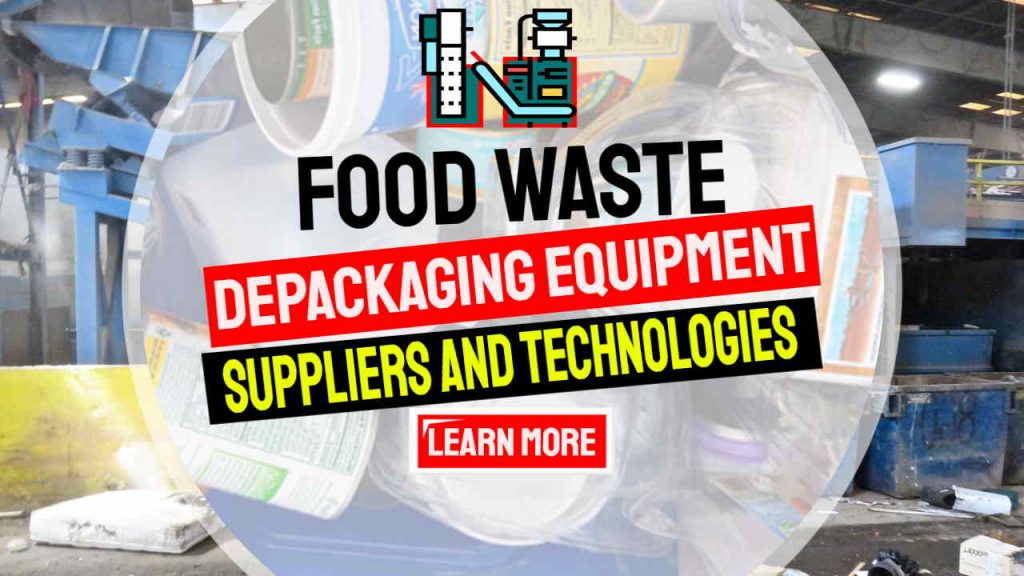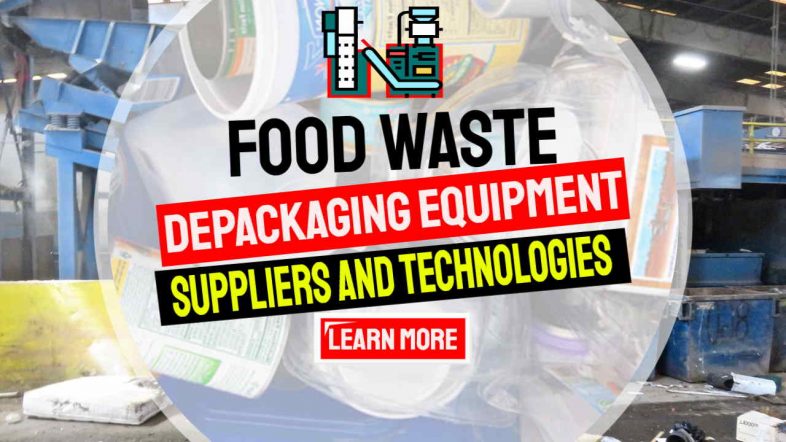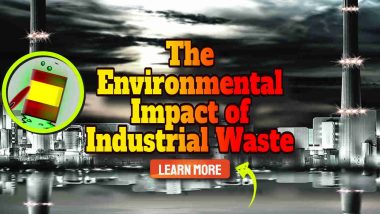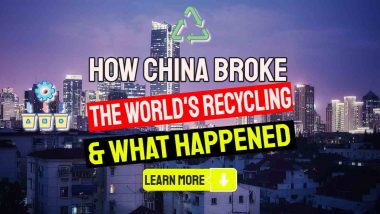The use of Food Waste Depackaging Equipment is becoming more popular as governments raise national requirements for organic waste recycling and seek to address the climate emergency. But which type of equipment is right for your facility, and who are the suppliers?
If you have a large-scale food processing operation, there is little doubt that you would benefit from purchasing a food waste depackaging system. However, even small businesses such as restaurants and supermarket branches may benefit, while always only using this means of disposal as a last resort. For example, depackaging should only be used on food that cannot be sent to a food bank, as designated in the national waste hierarchy.
Nowadays, the range of equipment offered is quite extensive.
In addition to the traditional suppliers of general MRF sorting equipment which have made modifications to their long-established particle size reduction equipment and branded their machines as depackagers, there are a number of newcomers.
The best of the newcomers have created novel techniques, to:
- combine multiple depackaging functions in one stage,
- reduce energy cost, raise reliability, and
- avoid microplastic production while also removing any that are already present in the incoming organic waste stream.
We refer to the use of physical separation in “vortex” and “turbo” systems. Of these, the combined use of a water-and-air vortex is very effective in excessive separation with minimum destruction. So far, digital separation equipment such as food waste ballistic separation has been absent from the specialist food waste multi-function single-unit systems.
Once one of the new depackaging systems has plucked the flexible plastics, bottles, packets, bags and film whole from the organic materials, techniques such as ballistics can be used once that output stream is added to MRF sorting lines.
The days of the old re-purposed grinders, shredding, and milling systems based on size reduction must now be numbered now that the “new kids on the block” have arrived with their purpose-designed systems using novel separation techniques.
In order to showcase the current range of depackaging equipment we provide the equipment round-up which now follows:
On This Page
- Why Buy a Food Waste Depackager?
- Points to Consider When Depackaging and Separating Organic Content
- Examples of Manufacturers of Food De-Packaging Machines
- Super Separator De-Packaging Machine
- The Dominator Depackager
- The Mavitec Paddle Depacker
- The Scott Separation System
- Twister Food Waste Processing Innovation
- Tiger Shredder for Food Waste
- Common Issues with Organic Waste Shredding Equipment
- Waste Plastic Recycling Machine manufacturers & suppliers
- Conclusion
Why Buy a Food Waste Depackager?
The primary economic driver for buying an organics packager is the value of the organic pulp stream when optimised in water content and purity and fed into the digester tank of an anaerobic digestion plant. However, although the majority of depackagers add water to make pulp or “organic soup” from the incoming organic content, some depackaging systems (such as the Twister by Drycake) can also be run with no added water introduced.
An example of this has been biscuit factory food waste. This is the result of out-of-specification biscuit production and the dry crumbs can readily be separated in that equipment. The result is that ongoing sales provide a nutritious cattle feed supplement of real commercial value and much sought after by many farmers.
A food waste depackaging machine will separate solid materials from organic materials. Using this equipment will improve the efficiency of Windrow/ IVC Composting and AD facilities. The latest models of food waste depackaging equipment feature a multi-action design that minimizes fragmented packaging. In at least one system rotating paddles and flails break down packaging, carrying empty packages along to the processing chamber. The rejects are then ejected using water or air and in the most advanced systems, they may use both.
Food waste depackaging equipment needs to remove almost all of the plastic from the food waste stream in a light rejects stream. If not the plastic may build up in a digester tank eventually causing huge disruption and cost to the operator while the accumulated material is dug out.
If at all possible this should be recycled for the plastic resin to be reused, not only to provide income to the organic waste producer but to avoid the huge cost of disposal as a waste which incurs high landfill fees. Unfortunately, this can only be achieved from one or two of the many equipment ranges available because the plastics in the output are contaminated by retained organic content and moisture which clings to the small and tiny pieces of plastic.
The heavy fraction output “reject” stream of the sand, silt, grit, and stones with small metal pieces from breaking up bottles, tins, and cans during milling and shredding are even more likely to go to landfill unless a philosophy of minimum fragmentation, and not size reduction, is integral to the equipment.
Important Points to Consider When Depackaging and Separating Organic Content
The following are important points to consider when depackaging and separating organic content from packaged food, source Segregated (SS) Waste, Organic Fraction MSW (OFMSW) and hospitality industry waste.
A food waste depackaging machine will separate solid materials from organic materials. Using this equipment will improve the efficiency of Windrow/ IVC Composting and AD facilities. The latest models of food waste depackaging equipment feature a multi-action design that minimizes fragmented packaging. Rotating paddles and flails break down packaging, carrying empty packages along to the processing chamber. The rejects can then be ejected using water or air and in the most advanced systems, they may use both.
Food Waste Depackaging Equipment should be gentle and not rely on size reduction. Size reduction is not a sustainable strategy as it increases the amount of microplastics, which will end up in the environment. Hence, food waste depackaging equipment should employ a combination of forces with multiple characteristics and reduce the risk of contamination.
The food waste depackaging market has evolved over the years, with newer separation equipment proving to be effective. Traditional shredding methods such as hammer mills create enormous amounts of microplastics.
Unfortunately, many manufacturers of depackaging equipment continue to peddle hammer mill-based machines which were not designed for depackaging, and therefore create a greater microplastic burden on our soils. The environmental regulators are waking up to the need to ban the use of these products, and this is just one example of the growing concern.

Examples of Manufacturers of Food De-Packaging Machines
Twister Depackager and Separator
The Twister Depackager, by relative newcomer Drycake, Canada, has been developed for the separation of organics and inorganics for the purpose of recycling and reuse of the material sorted.
This applies as much to treat the organic fraction of MSW (OFMSW) and Source Separated Organics (SSO), as to depackaging expired foods for manufacturers and supermarket waste.
The patented Twister design allows all types of food waste to be processed from processed food producer out-of-specification output to OFMSW to be separated even when it enters the depackaging unit in a plastic bag, shrink-wrapped or boxed. The organics can be used in an anaerobic digester for biogas production or prior to windrow or in-vessel composting. Seee more about the Twister below.
Smimo Depackaging Machine
The Smimo Depackaging Machine by SMICON is one of the originals and has been used to unpack packaged food since 2006. These depackaging machines discharge the organic contents through a sieve on one side and the packaging on the other side. The wear and tear parts are said to be easy to access and change.
The most suitable material for processing by the Smicon is moist food products in plastic packaging. The belt separator can crush unpacked moist organic matter.
These unpacking machines are available in a stainless steel version, making them resistant to attack by all foodstuffs. The Smimo depackaging machine by Smicon is available in a number of versions for different capacities, such as the Smimo 80, Smimo 120, and Smimo 160.
The Smicon BS260 Belt Separator can be used as a stand-alone depackaging machine. The BS260 is described as suitable for removing food from its packaging on a smaller scale and in batch-wise series.
In addition to the function as a stand-alone depackaging machine, the soft belt separator purifies the organic output of the Smimo machines even further for a cleaner organic output of your process.
Waste Food Solutions Ltd
Waste Food Solutions Ltd of York UK, provides food de-packaging machines to produce a high-quality animal feed.
The mixed organic food waste with its packaging is treated as it passes through their “Super Separator” de-packaging unit, which is stated to be in its 12th year of production,. The company states that it sells the recovered food to livestock farmers throughout the UK.
The feed is described as passing the tests which confirm that the feed meets the required standard for sale as a feed in this way.
The company's food waste equipment is sold to process inedible food from supermarkets, markets, food manufacturers, and other sources.
Super Separator De-Packaging Machines
Waste Food Solutions Ltd, of York UK, has coined the phrase “super separator de-packaging machines”. They offer food de-packaging and recycling machines. These are described as super separators for use for waste food recovery in order to produce a low-cost animal feed.
The Super Separator depackaging unit separates plastic bottles, tea bags, chips packs, cardboard boxes, Tetrapak packs, aluminium cans, etc.
As stated on their website, the equipment is designed to separate all dry and liquid expired or defective products from their packaging. They say that unpacked products can be converted into value-added products and easily recycled using their machines.
Their separator is available in various capacities according to customer demand. Rotor speed can be adjusted from the control panel and the sieve can be changed easily.
The Dominator Depackager
The dominator depackaging machine, originally conceived 30 years ago, uses a motor to drive a solid steel shaft lined with paddles. Using mechanical and centrifugal forces material is depackaged and the organic pulp content is forced through a mesh screen. Waste packaging makes its way through the barrel and out through the outlet.
Plastics and unwanted foreign objects from rejected food waste recovered food can either be dropped directly into a container below the Dominator Unit, mechanically conveyed away or pumped into a tank from which the processed plastics can then be recycled.
Based in Gloucestershire, United Kingdom the Dominator waste depackaging machine is designed to remove outer packaging and reuse waste that would have otherwise been sent straight to landfills. The machine is able to depackage dry and wet waste. The waste depackaging process is key to performance.
The Mavitec Green Energy Ltd Paddle Depacker
The Mavitec paddle depacker separates the organic material from the packaging and its maker says that it produces a very clean organic output that is suitable for use in biogas installations.
The reportedly 99.5% clean organic output is stated to comply with the latest European Legislation.
The latest laboratory results are described by Mavitec as showing less than 0.4% of physical impurities from various types of food waste.
The Scott Separation System
Scott Separation Systems is a company that has been trading for 50 years. The patented Scott system is intended, specifically for the recovery of organic materials from packaging. These recovered organics can be used for composting, animal nutrition supplements, and/or in anaerobic digestion for green energy production.
Semi-wet material shredders are described as suitable for all kinds of organic waste. In fertilizer production, shredding is often used as a pre-process of composting materials. You can use it to experience the highest quality compost materials at the lowest shredder price.
Twister Food Waste Processing Innovation
In December 2021 Twister™ announced its first sales of its innovative food waste depackager and separator in Europe and Asia. The small footprint, low energy use plastic waste reprocessing unit has broken into the growing EU and Asia markets for depackaging.
The Twister unit just launched had been in development since 2016. Recently introduced in Canada, it offers decentralised organic processing with unparalleled separation performance.
It expels each packet opened, emptied, and whole. The resultant clean food waste generated by the “twister” effect, is free of micro-plastics and ready for anaerobic digestion.
The vision at Drycake during development was for something new for the Twister.
The view for the Twister was not to resort to reducing the particle size while accomplishing depackaging and separation of source-separated organics and OFMSW.
Most competitor depackagers use particle size reduction to prevent clogging. Drycake uses no milling, macerating, chopping, or shredding which unfortunately reduces much of the plastic to small chips known as microplastic.
Tiger Shredder for Food Waste
From Doppstadt US, a division of Ecoverse industries, based in Avon, Ohio, is the Tiger HS640 depackager, shredder, and screener for food waste recycling and anaerobic digestion applications.
The tiger hs640 offers three functions in one piece of equipment, the company says. According to Ecoverse, the machine can process solid and liquid fractions, and organic wastes can be processed as they are. The company says the tiger helps to mitigate feedstock contamination because it is capable of removing organic materials, such as food waste, from packaging containers.
De-packaging and liquid separation are key processes for the volume and weight reduction of orgnic waste products. The process separates liquid from containers in order for the component parts to be recycled and reused. Typical applications include cosmetics, pharmaceuticals, distribution, paper mills, breweries, and food & beverage manufacturers.
We wanted something new for the Twister by Drycake said Mark Vanderbeken: Anyone familiar with the food waste depackaging market will probably have noticed how everyone else seems to start their depackaging and separation of source-separated organics by reducing the particle size.
Most competitor depackagers do this to prevent clogging. They use milling, macerating, chopping, or shredding to reduce the plastic to small chips.
But large pieces are easier to separate than smaller ones and why not perform the depackaging and separation stages together anyway?.
Common Issues with Organic Waste Shredding Equipment
Until recently recycling equipment suppliers have offered waste shredding and other particle size reduction equipment as the most environmentally sustainable solution for the destruction of expired, damaged, recalled, or off-spec food products.
However, there are a number of issues with this and the industry needs to do better as the volume of all organic wastes which require processing is rising rapidly in accordance with climate change abatement targets.
The following are some of the most common Issues with organic waste shredding/ particle size reduction equipment when used to process organic wastes:
- Organic waste usually contains plastics and small particles of plastic that, even if subsequently removed, are hard if not impossible to recycle due to the fact that:
– small pieces of similar specific gravity are difficult to sort into the original polymers for recycling as a plastic resin for use in new products
– small chips of plastic and shreds have a large surface area and will include pieces of the plastic film, all of which tend to hold water, reducing the calorific value and rendering the output unsuitable for energy recovery via incineration
– in addition to water the output also contains a percentage of organic matter, and any amount of organic matter lost from the pulp output reduces the amount of biogas that can be produced. - The presence of microplastics even when responsibly landfilled needs to be avoided as a matter of principle. No landfill will remain intact in anything even close to geological timescales. So, it can be assumed that even landfilled plastics will all eventually end up in the oceans of the world.
- Unless the organic waste is first subjected to a ferrous and non-ferrous metal removal stage any metal cans, tins, foil packaging, paint residue, zinc coatings, etc will be present in the heavy fraction intimately mixed in the grit, sand, and silt content. The valuable recyclable metal content is lost. At the same time, the inert output becomes still less suitable for any use on land as a soil substitute.
- Size reduction equipment, unlike in the quarrying industry for example, where size reduction adds real value to the output producing stone sizes essential for the construction industry adds no value of itself while consistently consuming more energy than less destructive processing techniques.
- Users report:
– poor uptime of shredding and milling equipment used for organic waste processing and
– maintenance intervals both less than normal industry standards and
– the cost of the component replacement is high at each service - High operative supervision time.
The advantage of particle size reduction is of course that handling a flow of mixed materials is much easier with the more consistent particle size shredding produces and clogging and jamming are reduced or eliminated.
Damage from Unexpected Items in the Waste
In defense of the equipment suppliers, it is of course true that a host of problems arise when unexpected items are thrown into organic waste collection bins by members of the public oblivious to the result. Predicting what may appear may not be possible.
Designing and maintaining equipment to handle all possible contingencies when dealing with food waste may be unrealistic.
On that subject, every operator has their own tale to tell. One operator was heard to say recently that having equipment that recently coped with a medieval cannonball with just one hour of downtime to remedy minor damage, still left him nervous for the day the cannon would show up in their organics feed.
While none of the current separators can cope with every eventuality of unexpected items. The industry should no longer accept equipment that requires a continuous manual inspection to pluck out foreign items.
Examples of Government Action to Reduce Food Waste and if not Recycle it
Californians rang in the new year in 2022 with the unfurling of a groundbreaking law that will change how they dispose of their organic waste, particularly leftover food and kitchen scraps.
California’s Short-Lived Climate Pollutant Reduction Strategy SB 1383is an example of forthcoming government action to reduce food waste and if not recycle it. Beginning in 2022, it requires every jurisdiction to provide organic waste collection services to all residents and businesses. “jurisdiction” means a city, county, a city-and-county, or a special district that provides solid waste collection services.
According to the Californian administration “organic waste” includes food, green material, landscape, and pruning waste, organic textiles and carpets, lumber, wood, paper products, printing and writing paper, manure, biosolids, digestate, and sludges.
Jurisdictions must now select from a variety of organic waste collection services to match their unique communities and local infrastructure, while producing clean streams of organic feedstock that can be recycled into high-quality, marketable recycled products, including compost, renewable natural gas, electricity, and paper.
Senate Bill 1383 requires all residents and businesses to separate such “green” waste from other trash, but the program will be rolled out gradually for homes and businesses in the coming months, with the actual startup date varying, depending on the location of your home or business.
Similar initiatives to our Californian example are underway across Europe and in the UK to raise Source Separated Organic Waste recycling.
Conclusion
The leading organic (food waste) packaging machines which have been designed for the purpose are able to separate organic materials from a huge range of packaging and a number of them quote 99% or better purity of the resulting organic paste (pulp/soup) output.
The challenge now is to produce a light fraction of mostly plastic materials which is suitable for sale as recycled resin that businesses can use to fulfill their quotas of recycled plastic content in single-use plastic products. By doing that, the plastic tax is avoided, the value of the separated plastic is maximized, and a multiple above the virgin resin price can be commanded.
Multi-purpose machines are available to open unpackage separate and clean everything from wax-coated cardboard to glass bottles, plastic bottles, aluminum cans, plastic films (e.g. bags) wrappers, and a vast range of ready-meal containers.
But to do this by size reduction when it is known that complete product destruction is no longer necessary by using the latest equipment should now be phased out on the grounds of unsustainable production of microplastics.
No longer is it necessary to generate microplastics, so the industry now needs to embrace and adopt this new technology, with the additional benefits maybe this should be sooner than later. By converting a rejects (waste) disposal cost to the income from a product with value the return on investment period can be remarkably short. When this occurs, the sooner operators seek out new equipment the sooner they may be able to raise the profitability of their operations.






